| Listing 1 - 10 of 20 | << page >> |
Sort by
|
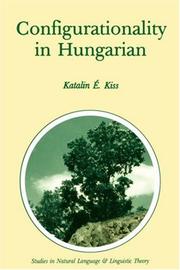
ISBN: 9027719071 9027724563 9400937032 Year: 1987 Publisher: Dordrecht
Abstract | Keywords | Export | Availability | Bookmark
 Loading...
Loading...Choose an application
- Reference Manager
- EndNote
- RefWorks (Direct export to RefWorks)
Hungarian language --- Grammar --- Hongrois --- Syntax --- Generative grammar --- Syntaxe --- Grammaire générative --- Grammaire générative
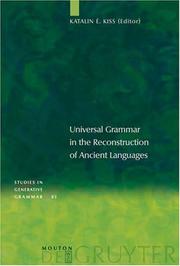
ISBN: 9783110185508 3110185504 3110902222 9783110902228 Year: 2005 Volume: 83 Publisher: Berlin Mouton de Gruyter
Abstract | Keywords | Export | Availability | Bookmark
 Loading...
Loading...Choose an application
- Reference Manager
- EndNote
- RefWorks (Direct export to RefWorks)
Philologists aiming to reconstruct the grammar of ancient languages face the problem that the available data always underdetermine grammar, and in the case of gaps, possible mistakes, and idiosyncracies there are no native speakers to consult. The authors of this volume overcome this difficulty by adopting the methodology that a child uses in the course of language acquisition: they interpret the data they have access to in terms of Universal Grammar (more precisely, in terms of a hypothetical model of UG). Their studies, discussing syntactic and morphosyntactic questions of Older Egyptian, Coptic, Sumerian, Akkadian, Biblical Hebrew, Classical Greek, Latin, and Classical Sanskrit, demonstrate that descriptive problems which have proved unsolvable for the traditional, inductive approach can be reduced to the interaction of regular operations and constraints of UG. The proposed analyses also bear on linguistic theory. They provide crucial new data and new generalizations concerning such basic questions of generative syntax as discourse-motivated movement operations, the correlation of movement and agreement, a shift from lexical case marking to structural case marking, the licensing of structural case in infinitival constructions, the structure of coordinate phrases, possessive constructions with an external possessor, and the role of event structure in syntax. In addition to confirming or refuting certain specific hypotheses, they also provide empirical evidence of the perhaps most basic tenet of generative theory, according to which UG is part of the genetic endowment of the human species - i.e., human languages do not "develop" parallel with the development of human civilization. Some of the languages examined in this volume were spoken as much as 5000 years old, still their grammars do not differ in any relevant respect from the grammars of languages spoken today.
Grammar --- Grammar, Comparative and general --- Extinct languages --- Extinct languages. --- Grammar, Comparative and general. --- Dead languages --- Languages, Extinct --- Comparative grammar --- Grammar, Philosophical --- Grammar, Universal --- Language and languages --- Philosophical grammar --- Grammar, Comparative --- Language obsolescence --- Linguistics --- Philology --- Grammaire comparée et générale --- Langues mortes --- Generative Linguistics. --- Indo-Germanic. --- Language Reconstruction.
Book
ISBN: 9780198709855 9780191780165 0191780162 9780191019784 019101978X 0198709854 Year: 2014 Publisher: Oxford Oxford University Press
Abstract | Keywords | Export | Availability | Bookmark
 Loading...
Loading...Choose an application
- Reference Manager
- EndNote
- RefWorks (Direct export to RefWorks)
This publication adopts a generative framework to investigate the diachronic syntax of Hungarian, one of only a handful of non-Indo-European languages with a documented history spanning more than 800 years. It focuses particularly on the restructuring of Hungarian syntax from head-final to head-initial and the resultant changes that occurred.
Hungarian language --- Historical linguistics --- Grammar --- FOREIGN LANGUAGE STUDY / Hungarian. --- Grammar, Comparative and general --- Syntax. --- Uralic and Basque Languages & Literatures --- Languages & Literatures --- Syntax
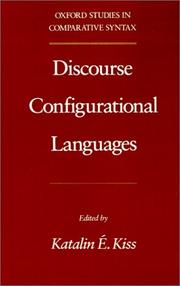
ISBN: 0195088344 0195088336 1280534877 0195358503 9780195358506 9780195088335 9786610534876 661053487X 9780195088342 0197721540 9781280534874 Year: 1995 Volume: *2 Publisher: New York Oxford University Press
Abstract | Keywords | Export | Availability | Bookmark
 Loading...
Loading...Choose an application
- Reference Manager
- EndNote
- RefWorks (Direct export to RefWorks)
Generatieve spraakkunst --- Generative grammar --- Grammaire générative --- Grammaire transformationnelle --- Grammar [Comparative and general ] -- Derivation --- Grammar [Generative ] --- Grammar [Transformational ] --- Grammar [Transformational generative ] --- Grammatica [Generatieve ] --- Grammatica [Transformationele ] --- Spraakkunst [Generatieve ] --- Spraakkunst [Transformationele ] --- Transformational generative grammar --- Transformational grammar --- Transformationele grammatica --- Transformationele spraakkunst --- Transformationele taaltheorie --- Grammar, Comparative and general --- Grammaire générative --- Sujet et prédicat --- Topic and comment --- Functional sentence perspective (Grammar) --- Predicate and subject (Grammar) --- Subject and predicate (Grammar) --- Theme and rheme --- Topic and comment (Grammar) --- Focus (Linguistics) --- Grammar, Generative --- Grammar, Transformational --- Grammar, Transformational generative --- Psycholinguistics --- Subject and predicate --- Syntax --- Derivation --- Grammar [Comparative and general ] --- Generative grammar. --- Topic and comment. --- Linguistics --- Philology
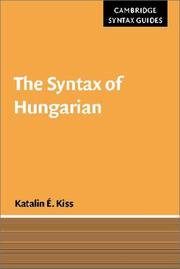
ISBN: 0521660475 0521669391 9780521660471 9780521669399 1107128382 1280432535 0511148461 0511305354 0511177976 0511048513 0511755082 9780511755088 0511020651 9780511020650 9780511148460 9780511048517 9781107128385 9781280432538 9780511305351 9780511177972 Year: 2002 Publisher: Cambridge Cambridge University Press
Abstract | Keywords | Export | Availability | Bookmark
 Loading...
Loading...Choose an application
- Reference Manager
- EndNote
- RefWorks (Direct export to RefWorks)
Clearly written and comprehensive in scope, this is an essential guide to syntax in the Hungarian language. It describes the key grammatical features of the language, focusing on the phenomena that have proved to be theoretically the most relevant and have attracted the most attention. The analysis of Hungarian in the generative framework since the late Seventies has helped to bring phenomena which are non-overt in the English language into the focus of syntactic research. As Kiss shows, its results have been built into the hypotheses that make up universal grammar. The textbook explores issues at the centre of theoretical debates including the syntax and semantics of focus, the analysis of quantifier scope, and negative concord. This useful guide will be welcomed by students and researchers working on syntax and those interested in Finno-Ugric languages.
Hungarian language --- 809.451 --- Syntax --- Hongaars --- Syntax. --- Arts and Humanities --- Language & Linguistics
Digital
ISBN: 9781402047558 Year: 2008 Publisher: Dordrecht Springer
Abstract | Keywords | Export | Availability | Bookmark
 Loading...
Loading...Choose an application
- Reference Manager
- EndNote
- RefWorks (Direct export to RefWorks)
Lexicology. Semantics --- Linguistics --- semantiek --- syntaxis --- linguïstiek
Book
Year: 2007 Publisher: Dordrecht Springer
Abstract | Keywords | Export | Availability | Bookmark
 Loading...
Loading...Choose an application
- Reference Manager
- EndNote
- RefWorks (Direct export to RefWorks)
Book
ISBN: 963054184X Year: 1987 Publisher: Budapest Akademiai Kiado
Abstract | Keywords | Export | Availability | Bookmark
 Loading...
Loading...Choose an application
- Reference Manager
- EndNote
- RefWorks (Direct export to RefWorks)
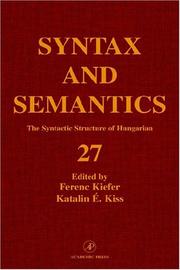
ISBN: 0126135274 9004373179 Year: 1994 Volume: 27 Publisher: San Diego, Calif. Academic Press
Abstract | Keywords | Export | Availability | Bookmark
 Loading...
Loading...Choose an application
- Reference Manager
- EndNote
- RefWorks (Direct export to RefWorks)
Hungarian syntax has played a vital, albeit much debated role in linguistic theory since the early 1980s. Volume 27 of "Syntax and Semantics" is the result of a project on Hungarian syntax launched in the early 1980s at the Research Institute for Linguistics of the Hungarian Academy of Sciences. The volume illuminates relevant and insightful aspects of Hungarian syntax. It assumes the basic theoretical claims and the basic methodology of generative linguistic theory, and shows that descriptive grammar is best approached by posing theoretically interesting questions. It features comprehensive coverage of Hungarian syntax and presents a complete analysis of salient questions and theories. It offers new insights into Hungarian syntax and discusses the important role Hungarian syntax has played in linguistic theory throughout the past decade.
Hungarian language --- Grammar --- Hongrois --- Syntax --- Syntaxe --- -Magyar language --- Finno-Ugric languages --- -Syntax --- Syntax. --- Hungarian language. --- Magyar language
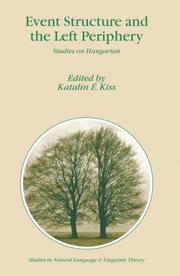
ISBN: 1280611707 9786610611706 140204755X 1402047533 1402047541 1281118508 Year: 2006 Publisher: Dordrecht : Springer,
Abstract | Keywords | Export | Availability | Bookmark
 Loading...
Loading...Choose an application
- Reference Manager
- EndNote
- RefWorks (Direct export to RefWorks)
This book provides substantial new results in a novel field of research examining the syntactic and semantic consequences of event structure. The studies of this volume examine the hypothesis that event structure correlates with word order, the presence or absence of the verbal particle, the [+/- specific] feature of the internal argument, aspect, focusing, negation, and negative quantification, among others. The results reported concern the telicising vs. perfectivizing role of the verbal particle; the syntactic and semantic differences of verbs denoting a delimited change, and those denoting creation or coming into being; evidence of viewpoint aspect in a language with no morphological viewpoint marking; the aspectual role of non-thematic objects; the source of the ‘exhaustive identification’ function of structural focus; the interaction of negation and aspect etc.
Hungarian language --- Syntax. --- Grammar. --- Grammar, Comparative and general. --- Semantics. --- Theoretical Linguistics. --- Formal semantics --- Semasiology --- Semiology (Semantics) --- Comparative linguistics --- Information theory --- Language and languages --- Lexicology --- Meaning (Psychology) --- Comparative grammar --- Grammar --- Grammar, Philosophical --- Grammar, Universal --- Philosophical grammar --- Linguistics --- Philology --- Grammar, Comparative --- Linguistics. --- Linguistic science --- Science of language --- Grammar, Comparative and general Syntax --- Syntax
| Listing 1 - 10 of 20 | << page >> |
Sort by
|

 Search
Search Feedback
Feedback About UniCat
About UniCat  Help
Help News
News